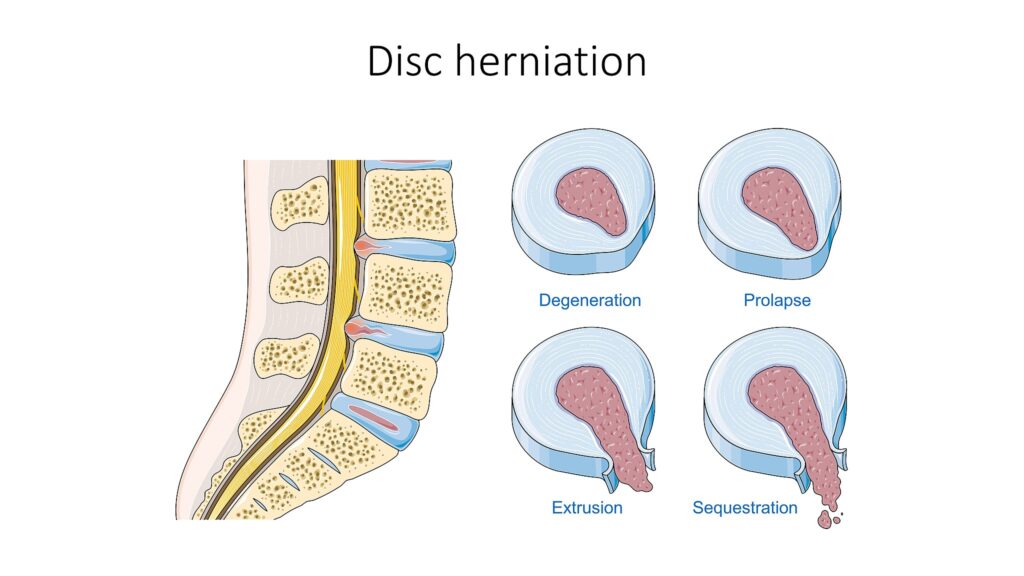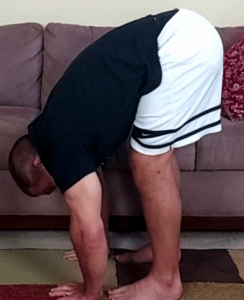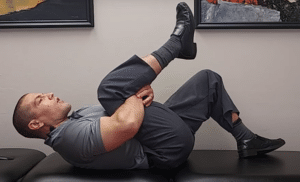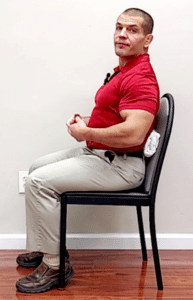What's the difference between a herniated disc vs disc bulge? Which is worse, and how do you know if you'll need surgery or not?
Watch the video to learn the difference between a herniated disc vs bulging disc. Plus, learn exercises to relieve bulging and herniated disc pain without surgery.

What The Difference Between A Herniated Disc vs Disc Bulge?
The discs are shaped like a jelly doughnut, with a hard outside called the annulus fibrosis and a soft inside called the nucleus pulposis.
Now, with a bulge, that nucleus starts to bulge out a little bit into the annulus but not all the way through.
Once the nucleus starts pushing the outer wall of the annulus out, it's called a protrusion, which is the first stage of a herniation.
The 4 stages of a disc bulging and herniations are:
- Bulge - the nuclear material starts to push out against the annulus
- Protrusion - a focal part of the discs starts to protrude into the annulus
- Extrusion - the protrusion goes all the way through the
- Sequestration - a piece of the herniation breaks off.
Stages 2-4 are considered disc herniations.
So, a herniation is really just a bigger version of a bulge.
Will I Need Surgery For A Bulging or Herniated Disc?
The good news is that most of the time, surgery isn't needed for a bulging or herniated disc.
By the time you get to be about 50 years of age, about 60% of people without any pain have a bulge in their disc according to a study in American Journal of Neuroradiology.
Only about 36% of people without any pain have disc protrusion, so disc herniations are more likely to cause you pain... but they don't have to.
And even if your herniated discs are the cause of your pain, it's still unlikely that you'll need surgery.
In most cases, having back pain is NOT a good indication for back surgery.
Unless you're having trouble with your bowel or bladder function or you have leg weakness that's getting worse over time, you're probably not going to need surgery.
In fact, most surgeons will tell you that they can probably fix your leg pain, but they can't guarantee that the back pain will go away.
How Do You Relieve Herniated Disc Pain Without Surgery>
The answer is pretty common sense:
To relieve herniated disc pain without surgery, do more of the things that make you feel better and less of the things that make you feel worse.
The classic herniated disc is thought to hurt more when you do forward bending or rounded positions of your spine.
These may include bending forwards, sitting down in a chair for a long period of time, or driving in the car for a long period of time.
But the older you get, the less likely those bending or flexion positions are to bother you.
Conversely, straight-spine positions (extension) my be more likely to bother you.
This can be true if you have a bulging disc or a herniated disc. It's especially true if you have degenerative discs or disc height loss.
So, how do you tell what type of treatment is better for you?
Again, do more of the things that make you feel better and less of the things that make you feel worse.
Try This Simple At-Home Test
Stand and take note of how you feel.
Do you have any symptoms in your back or any symptoms in your leg?
Next end forwards as if you're going to touch your toes. Just go as far as you can comfortably
Take note of if your pain gets better or worse.
If bending forward makes you feel better and kind of relieves your pain, then you probably want to do more bending activities.
Now, bending and standing can sometimes be painful just because you have to activate your muscles.
There are other ways that you can do bending exercises.
For example, lying on the floor and pulling one knee or both of your knees up to your chest.
Take note, does that make you feel better or does that make you feel worse?
And again, if that feels better, do more of that. If that makes you feel worse, do less of that.
You can also do forward bending from a chair.
If bending from standing is painful but you have trouble getting on or off the floor, you can also try bending forwards in a chair.
If this makes you feel better, doing forward bending stretches sitting down like this may be a good option for you.
If it makes you feel worse, then don't do that.
Now, let's say that you do feel worse in bending positions.
In that case, try standing up and bending backward.
Does your pain get any better? Does your pain get any worse? Or does it stay about the same?
If that makes your pain better, then do that throughout your day—stand up and lean backward.
That's particularly important particularly if you have an office job where you're sitting for long periods of the day.
Standing up and doing some of that backward bending motion may be good for you.
If you sit for long periods of time, try putting a towel or a lumbar roll behind your back. This helps maintain the normal curve in your lower back.
There are other ways that you can do backward bending movements as well.
Prone Press-Up Exercise
One common lumbar extension exercise is a press-up.
Be careful not to hinge from the lowest part of your back (L4-L5 or L5-S1). That's where herniated discs and disc bulges are most common.
Instead, you want to try to move evenly throughout all the segments in your lower back.
There should be a smooth curve arch rather than just hinging from the lowest point on your back.
Other Exercises For Bulging and Herniated Discs
What do you do if you find out that neither forward nor backward bending are helpful?
Well, there are other things that can affect herniated discs as well.
For example, the discs are designed to bear compression of your spine.
However, if the disc is bulging or herniated, spinal can cause the disc to further bulge and can create more pain.
Therefore, you probably also want to avoid things that create excessive compression. This may include carrying heavy backpacks or lifting heavy weights.
Conversely, hanging from a pull-up bar or stretching on a chair or desk can help decompress your spine.
If that feels good decompression exercise more often. You may even consider using an inversion table if decompression seems to help.
Teeter FitSpine LX9 Inversion Table, Del...
9% OffTreatment For Bulging and Herniated Discs
If you do have a herniated disc or disc bulge, it's generally best not to try to treat it on your own.
Getting professional treatment for bulging and herniated discs is a good idea.
Seeing a physical therapist who specializes in back problems can help you figure out:
- What's causing your back pain
- What you can do to relieve it how to
- How to keep it from coming back in the future
If you happen to be in the St. Louis area and need help for back pain, we'd be happy to help you.
Just tap the button below to request an appointment from one of our specialist physical therapists.
Like this post? Here are other posts about degenerative, bulging and herniated discs
Things To Avoid With Degenerative Disc Disease and What To Do Instead
Can You See A Slipped Disc On MRI?
Best Back Brace For Degenerative Disc Disease, Spinal Stenosis, and Sciatica















